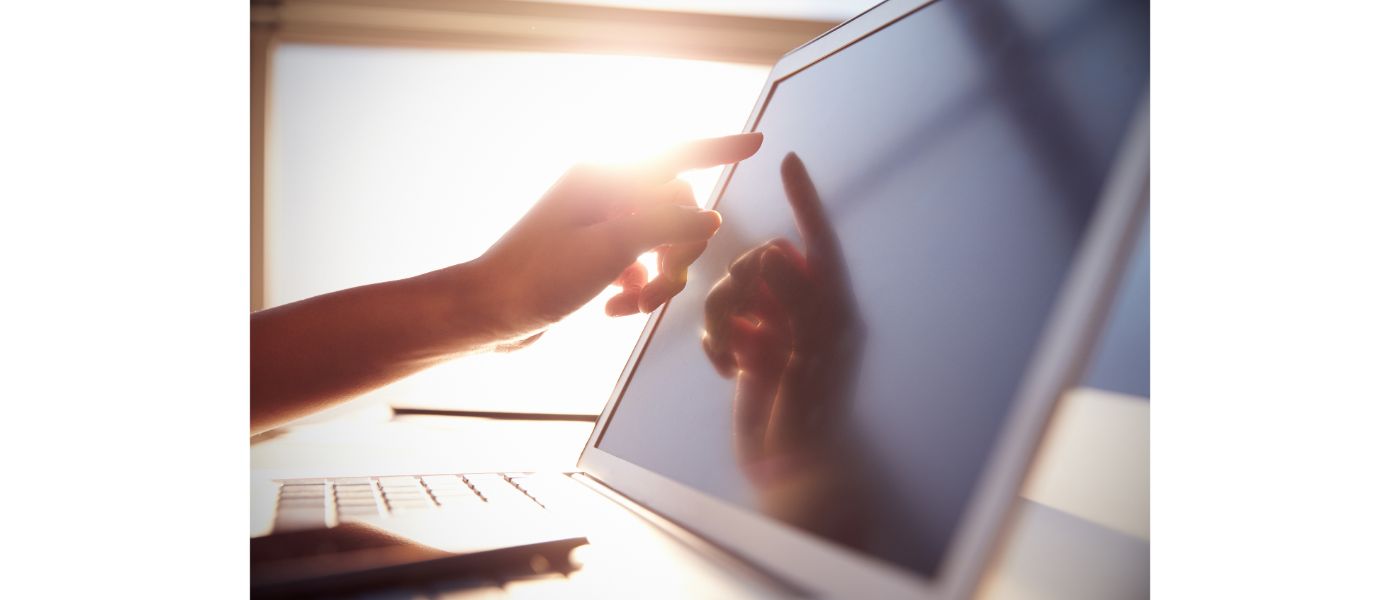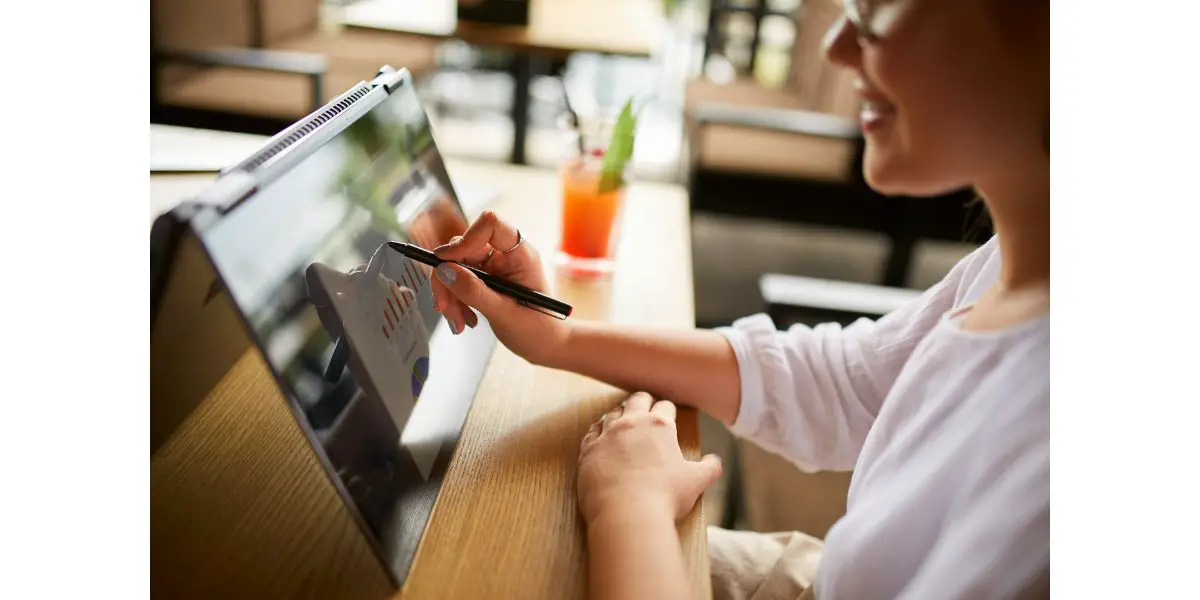Disclaimer: This post may contain affiliate links, meaning we get a small commission if you make a purchase through our links, at no cost to you. For more information, please visit our Disclaimer Page.
In this guide, I’ll showcase the pros and cons of touchscreen laptops and their effect on the laptop’s battery life, helping you decide whether to buy these PCs.
Table of Contents
How Touchscreen on a Laptop Affects Battery Life
Yes, touchscreen laptops do drain more battery from a PC compared to non-touchscreen laptops. However, this shouldn’t completely discourage you from purchasing one, as the touchscreen feature could offer your desired benefits.
To understand how a touchscreen may drain your laptop’s battery, we must first understand how touchscreens work.
There are two types of touchscreens currently used in the technology markets, and these are capacitive and resistive touchscreens. You’ll find resistive touch screens in places like bank ATMs, where security policies require a screen that isn’t too sensitive.
Smartphones, tablets, and laptops use a capacitive touchscreen made up of several layers of glass and plastic covered with a conductor material like copper.
When your bare finger, which has electric current, meets this conductive material, it sends a signal to the operating system as a touch event.
Furthermore, these screens tend to have a high resolution to give users a high-image quality and a seamless experience when giving instructions to the device.
All these features are an added constraint on the battery’s longevity. Your PC’s ability to conduct electricity from your finger through the screen and send corresponding signals to the operating system takes power from the battery.
The table below showcases the differences in battery life for a selected number of laptops of the same model but with different screens. It highlights the drastic difference in battery drainage.
| Laptop | Battery life (Hrs) |
|---|---|
| Thinkpad T460 (non-touch) | 17:04 |
| Thinkpad T460 (touch) | 13:12 |
| Dell XPS 13 (Non-touch) | 11:54 |
| Dell XPS 13 (QHD, touch) | 8:08 |
| EliteBook Folio (non-touch) | 7:02 |
| EliteBook Folio (4K, touch) | 4:35 |
Can You Minimize the Use of Battery on a Touchscreen Laptop
Windows manager has an option to disable the touchscreen function on your PC, but unfortunately, this doesn’t mean your battery will be spared.
Users have done several tests on this matter and have realized that using your touchscreen and failing to use it are pretty much the same thing, and if you are to save on battery, it is by a very minimal percentage.
These PCs were designed to have this touchscreen feature, so even when it’s turned off and idle, it’s still draining the battery because of the technology infused into the system.
Cons of a Touchscreen Laptop
The touchscreen feature has revolutionized technology but isn’t necessary for all gadgets. Apple, which was the pioneer of the multi-touch doesn’t have the touchscreen feature on any of their Macbooks because the brand felt it wasn’t a reasonable add-on to their laptops.
Apple’s reasoning for this is briefly highlighted in the video below:
It’s Inconvenient in Certain Situations
When you have a touchscreen laptop, you must stretch your hand from the trackpad and keyboard to the screen whenever you want to command the PC. This, frankly, isn’t realistic or convenient.
If you’re using a Windows laptop, you’ll know that operating systems like Windows 10 highlight the apps designed for touch and those designed for keyboard and mouse usage.
You’ll find it easy to navigate the apps that were made for touch because their icons are big and there’s enough screen space, but applications like file explorer have small icons and many contents hidden under other contents, which makes it that much hard to navigate with a finger.
Touchscreen Laptops Are More Bulky
This might not be a complete dealbreaker for some people, but if you carry your PC daily for work or school, bulkiness is a complete red flag.
The bump-up size is approximately 0.2 to 0.4 pounds (90 to 181 grams) due to the screen and the added touchscreen technology.
Poor Viewing Experience in Some Situations
Touchscreens by design are glossy to support the high-image quality required. However, as a result, you’ll find that the viewing experience isn’t desirable, especially outdoors.
Once light, like sunlight, is cast upon the screen, it will be difficult to view what’s on your screen. Also, if you’re using the screen for viewing with multiple people, you’ll find that the people at the sides only see their reflections and not what’s on the screen.
You Have to Deal With A Maze of Fingerprints on the Screen
This might not bother everyone, but a screen that needs cleaning several times can be a little tedious, especially if the kids use it.
You’ll find smudges of chocolate and more, and you must wipe it down, which you wouldn’t deal with if you just had a traditional PC with a screen.
Touchscreen Laptops Are Pricy
If the points above don’t shy you away, the price point might. Most touchscreen laptops like the Dell XPS 13 have a drastically varying price point from the non-touch screen. Yes, they add a bump in the screen resolution, but you might not need that on your PC.
It’s understandable why they are much pricier because of the added feature that greatly transforms the use of the PC from an ordinary one, but price should always reflect in value.
Pros of a Touchscreen Laptop
There are undeniably good reasons why you might purchase these laptops. I’d suggest that instead of buying a traditional laptop with a touchscreen, opt for either the 2-in-1 that can fold into a tablet or one with a detachable keyboard and screen.
The two options offer great benefits that I’ll discuss below. Additionally, their interfaces were designed to support the functionality and awesomeness of touch.
Touchscreen Laptops Are Great for Graphic Designers and Students
These PCs are the best for you if you’re in the field of drawing and design, like graphic design, animation, or even architecture. They support drawing, taking notes, etc, by using the stylus pen on a responsive screen.
Also, if you have kids, a detachable laptop or 2-in-1 could be great for them to learn how to draw and paint, giving them something to keep their minds sharp.
Touchscreen Laptops Increase the Convenience of Navigation
The ease of navigation made touchscreen mobile phones transform the mobile industry, which you’ll experience with some of these PCs. You’ll have the touch options if you ever have a problem with your mouse or trackpad.
When using apps made for touchscreen laptops, especially with tools like styluses, interacting with a touchscreen laptop can be easy, efficient, and enjoyable.
If you need more information, this piece highlights the worth of touchscreen laptops, which could assist you in making a clearer purchasing decision.
Final Thoughts
Touchscreen laptops offer a range of benefits, but they may only be truly valuable to some users.
If you’re using your laptop for ordinary tasks like writing or even complex tasks like video editing, you’ll find that more times than not, the touch feature is getting in your way instead of adding to your experience.
If you desire to purchase this laptop nonetheless, I recommend the 2-in-1 laptop or the detachable laptop for more convenience and value in your machine.


